
Tanks in the Cold War
Encyclopedia
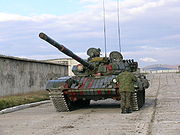
Warsaw Pact
The Warsaw Treaty Organization of Friendship, Cooperation, and Mutual Assistance , or more commonly referred to as the Warsaw Pact, was a mutual defense treaty subscribed to by eight communist states in Eastern Europe...
countries on the one side, and the North Atlantic Treaty Organization (NATO) countries on the other side. The Warsaw Pact was seen by the West as having an aggressive force outnumbering the NATO forces.
Soviet domination of the Warsaw Pact led to effective standardization on a few tank designs. In comparison, NATO adopted a defensive posture. The major contributing nations, France, Germany, the USA, and the UK developed their own tank designs, with little in common, while the smaller nations of NATO purchased or adapted these designs.
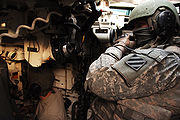
Many of the changes in tank design have been refinements to targeting and ranging (fire control
Fire-control system
A fire-control system is a number of components working together, usually a gun data computer, a director, and radar, which is designed to assist a weapon system in hitting its target. It performs the same task as a human gunner firing a weapon, but attempts to do so faster and more...
), gun stabilisation, communications and crew comfort. Armour has evolved to keep pace with improvements in weaponry, and guns have grown bigger. But there have been no fundamental changes.
The design and budgeting of tanks has known severe ups and downs. Right after the war, tank design budgets were cut and engineering staff was often scattered. Many war planners believed that the tank was obsolete, now that nuclear weapons were on the scene. It was felt that a tactical nuclear weapon
Nuclear weapon
A nuclear weapon is an explosive device that derives its destructive force from nuclear reactions, either fission or a combination of fission and fusion. Both reactions release vast quantities of energy from relatively small amounts of matter. The first fission bomb test released the same amount...
could destroy any brigade or regiment, whether it was armoured or not. The Korean war
Korean War
The Korean War was a conventional war between South Korea, supported by the United Nations, and North Korea, supported by the People's Republic of China , with military material aid from the Soviet Union...
proved that tanks were still useful on the battlefield, given the hesitation of the great powers to use nuclear weapons. In the 1950s, many nations' tanks were equipped with NBC protection, allowing mechanized units to defend against nuclear, biological and chemical weapons, or to conduct breakthroughs by exploiting battlefield nuclear strikes.
Development of the main battle tank
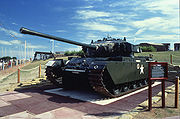
Main battle tank
A main battle tank , also known as a battle tank or universal tank, is a tank that fills the heavy direct fire role of many modern armies. They were originally conceived to replace the light, medium, heavy and super-heavy tanks. Development was spurred onwards in the Cold War with the development...
. This transition happened gradually in the 1950s, as it was realized that medium tanks could carry guns (such as the US 90 mm, Soviet 100
D-10 tank gun
The D-10 is a Soviet antitank gun developed in late World War II, and installed in tank destroyers and tanks. Versions of the 100 mm gun were installed on new T-55 tanks as late as 1979, and continue to be in active service in many countries.- History :...
mm, and especially the British L7 105 mm
Royal Ordnance L7
The Royal Ordnance L7 is the basic model of Britain's most successful tank gun. The L7 was a 105 mm L/52 rifled design intended for use in armoured fighting vehicles...
) that could penetrate any practical level of armor at long range. The World War II concept of heavy tanks, armed with the most powerful guns and heaviest armor, became obsolete since they were just as vulnerable as other vehicles to the new medium tanks. Likewise, World War II had shown that lightly armed, lightly armored tanks were of little value in most roles. Even reconnaissance vehicles had shown a trend towards heavier weight and greater firepower during World War II; speed was not a substitute for armor and firepower.

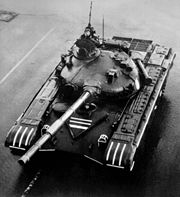
Centurion tank
The Centurion, introduced in 1945, was the primary British main battle tank of the post-World War II period. It was a successful tank design, with upgrades, for many decades...
, the Soviet T-55
T-55
The T-54 and T-55 tanks were a series of main battle tanks designed in the Soviet Union. The first T-54 prototype appeared in March 1945, just before the end of the Second World War. The T-54 entered full production in 1947 and became the main tank for armored units of the Soviet Army, armies of...
series, and the US M47
M47 Patton
The M47 Patton is an American medium tank, the second tank to be named after General George S. Patton, commander of the U.S. Third Army during World War II and one of the earliest American advocates of tanks in battle. It was a further development of the M46 Patton tank.-History:The M47 was the U.S...
and M48 series
M48 Patton
The M48 Patton is a medium tank that was designed in the United States. It was the third and final tank to be officially named after General George S. Patton, commander of the U.S. Third Army during World War II and one of the earliest American advocates for the use of tanks in battle It was a...
. These three basic vehicles were upgraded significantly over time. For example, the Centurion began life with the highly effective 17-pounder (76.2 mm) gun, but was upgraded to 20 pounder (84 mm) and then 105 mm main armament by 1959, with improved fire control and new engines.
The Russian T-55 started with a 100 mm gun, but has been upgraded with both 105 mm and 125 mm guns, much improved fire control systems, new engines, track, etc. The M47 series evolved through to the M60
M60 Patton
The 105 mm Gun Full Tracked Combat Tank, M60, also known unofficially as the M60 Patton, is a first-generation main battle tank introduced in December 1960. It was widely used by the U.S. and its Cold War allies, especially those in NATO, and remains in service throughout the world today...
series.The first Soviet main battle tank was the T-64
T-64
The T-64 is a Soviet main battle tank, introduced in the early 1960s. It was used solely by the Soviet Army in its front-line divisions and was a more advanced counterpart to the T-62...
while the first American MBT was the M60 Patton
M60 Patton
The 105 mm Gun Full Tracked Combat Tank, M60, also known unofficially as the M60 Patton, is a first-generation main battle tank introduced in December 1960. It was widely used by the U.S. and its Cold War allies, especially those in NATO, and remains in service throughout the world today...
.
These vehicles and their derivatives formed the bulk of the armored forces of NATO and the Warsaw Pact throughout the Cold War
Cold War
The Cold War was the continuing state from roughly 1946 to 1991 of political conflict, military tension, proxy wars, and economic competition between the Communist World—primarily the Soviet Union and its satellite states and allies—and the powers of the Western world, primarily the United States...
. Some of them remain in use in the 21st century.
Light tanks

Airborne forces
Airborne forces are military units, usually light infantry, set up to be moved by aircraft and 'dropped' into battle. Thus they can be placed behind enemy lines, and have an ability to deploy almost anywhere with little warning...
, and in rapid intervention forces which were not expected to face enemy tanks. The Soviet PT-76
PT-76
The PT-76 is a Soviet amphibious light tank which was introduced in the early 1950s and soon became the standard reconnaissance tank of the Soviet Army and the other Warsaw Pact armed forces. It was widely exported to other friendly states, like India, Iraq, North Korea and North Vietnam. Overall,...
is a good example of a specialized light tank. It is amphibious and has the firepower to kill other reconnaissance vehicles, but it is very lightly armored. The US M551 Sheridan
M551 Sheridan
The M551 Sheridan was a light tank developed by the United States and named after Civil War General Philip Sheridan. It was designed to be landed by parachute and to swim across rivers. It was armed with the technically advanced but troublesome M81/M81E1 152mm gun/launcher which fired conventional...
had similar strengths and weaknesses, but could also be airdropped, either by parachute or LAPES
Lapės
Lapės is a small town in Kaunas County in central Lithuania. As of 2001 it had a population of 1038.-References:*This article was initially translated from the Lithuanian Wikipedia....
.
Heavy tanks
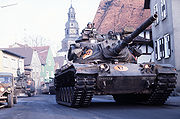
Tank gun
A tank gun is the main armament of a tank. Modern tank guns are large-caliber high-velocity guns, capable of firing kinetic energy penetrators, high explosive anti-tank rounds, and in some cases guided missiles. Anti-aircraft guns can also be mounted to tanks.-Overview:Tank guns are a specific...
, and with high accuracy meant that heavy tanks could no longer function in the stand-off, or overwatch role. Much cheaper antitank guided missiles could fill this role just as well. Medium tanks were just as vulnerable to the new missiles, but could be fielded in greater numbers and had higher battlefield mobility. Furthermore, the value of light tanks for scouting was diminished greatly by helicopters, although many light tanks continued to be fielded.
The development of antitank weapons and countermeasures
There was also talk that tanks were obsolete and budgets decreased a bit after the Yom Kippur WarYom Kippur War
The Yom Kippur War, Ramadan War or October War , also known as the 1973 Arab-Israeli War and the Fourth Arab-Israeli War, was fought from October 6 to 25, 1973, between Israel and a coalition of Arab states led by Egypt and Syria...
of 1973 when Israeli tanks were destroyed in unheard of quantities by man-portable wire guided missiles (ATGMs), fired by Egyptian infantry. Subsequent analysis showed that Israeli forces had underestimated their opponents during the first phases of the war; their all-tank tactics ignored the newfound ability of Infantry armed with cheap AT weapons to stop tanks. The solution to this new battlefield environment was both tactical and technical. Tactically, there was renewed recognition for the need for combined-arms tactics. This led to greater mechanization of Infantry and advanced artillery tactics and warheads. Tanks alone were vulnerable to Infantry, but a combined team of tanks, mechanized Infantry, and mechanized artillery could still win in the new environment.
In 1974, the United States initiated an impressive programme to modernise its existing tank fleet and start real mass production of the M60A1, and later the M60A3; at the same time the M1 was developed. Budgets for tank design and production picked up during the administration of president Ronald Reagan
Ronald Reagan
Ronald Wilson Reagan was the 40th President of the United States , the 33rd Governor of California and, prior to that, a radio, film and television actor....
, as the cold war threatened to get hot.
In response to infantry-portable and vehicle-mounted ATGMS, ever more capable defences were developed. Spaced armour
Vehicle armour
Military vehicles are commonly armoured to withstand the impact of shrapnel, bullets, missiles, or shells, protecting the personnel inside from enemy fire. Such vehicles include tanks, aircraft, and ships....
, composite
Composite armour
Composite armour is a type of vehicle armour consisting of layers of different material such as metals, plastics, ceramics or air. Most composite armour are lighter than their all-metal equivalent, but instead occupy a larger volume for the same resistance to penetration...
, explosive reactive armour, and active protection system
Active protection system
An active protection system is a system designed to prevent sensor-based weapons from acquiring and/or destroying a target....
s—like the Russian Shtora
Shtora
Shtora is an electro-optical active protection system or suite for tanks, designed to disrupt the laser target designation and rangefinders of incoming anti-tank guided missiles...
, Drozd
Drozd
Drozd is an active protection system developed in the Soviet Union, designed for increasing tanks' protection against anti-tank missiles and RPGs. It is considered the world's first operational active protection system, created in 1977–78 by A...
, and Arena—were added to old and new tanks. Despite these improvements the larger missiles remained highly effective against tanks. This was demonstrated in 1991 when in a friendly fire
Friendly fire
Friendly fire is inadvertent firing towards one's own or otherwise friendly forces while attempting to engage enemy forces, particularly where this results in injury or death. A death resulting from a negligent discharge is not considered friendly fire...
incident, Hellfire anti-tank missiles destroyed one of the latest M1 Abrams
M1 Abrams
The M1 Abrams is a third-generation main battle tank produced in the United States. It is named after General Creighton Abrams, former Army Chief of Staff and Commander of US military forces in Vietnam from 1968 to 1972. The M1 is a well armed, heavily armored, and highly mobile tank designed for...
tanks.
Missile armed tanks
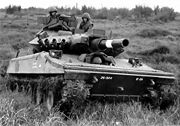
Smoothbore
A smoothbore weapon is one which has a barrel without rifling. Smoothbores range from handheld firearms to powerful tank guns and large artillery mortars.-History of firearms and rifling:...
or (in the case of "Shillelagh") a rifled main gun barrel with a provision to prevent imparting "spin" to the missile. In the U.S., the M60A2, M551 Sheridan
M551 Sheridan
The M551 Sheridan was a light tank developed by the United States and named after Civil War General Philip Sheridan. It was designed to be landed by parachute and to swim across rivers. It was armed with the technically advanced but troublesome M81/M81E1 152mm gun/launcher which fired conventional...
, and prototype MBT-70, with 152 mm barrel/launchers used the Shillelagh
MGM-51 Shillelagh
The Ford MGM-51 Shillelagh was an American anti-tank guided missile designed to be launched from a conventional gun . It was originally intended to be the medium-range portion of a short, medium, long-range system for armored fighting vehicles in the 1960s and '70s to defeat future armor without an...
infrared
Infrared
Infrared light is electromagnetic radiation with a wavelength longer than that of visible light, measured from the nominal edge of visible red light at 0.74 micrometres , and extending conventionally to 300 µm...
-guided missile.
The MBT-70 was cancelled prior to production due to high cost, and superseded by the M1 Abrams
M1 Abrams
The M1 Abrams is a third-generation main battle tank produced in the United States. It is named after General Creighton Abrams, former Army Chief of Staff and Commander of US military forces in Vietnam from 1968 to 1972. The M1 is a well armed, heavily armored, and highly mobile tank designed for...
, which used a conventional gun. The M551 and the M60A2 were widely considered disappointing due to problems of overall complexity, sensitive advanced electrical systems (some components of which involved the Shillelagh guidance system) and issues related to the conventional rounds with combustible cases, though the Sheridan would serve into the 1990s before finally being withdrawn. The M60A2's were eventually replaced by M60A3s using conventional 105 mm guns.
While U.S. experiments with gun-launched missiles led to a dead end, the Soviet Union
Soviet Union
The Soviet Union , officially the Union of Soviet Socialist Republics , was a constitutionally socialist state that existed in Eurasia between 1922 and 1991....
put this technology into service in the mid-1970s, and it continues to be used in CIS
Commonwealth of Independent States
The Commonwealth of Independent States is a regional organization whose participating countries are former Soviet Republics, formed during the breakup of the Soviet Union....
forces. Tanks capable of firing gun-launched missiles in Russian service include the T-72
T-72
The T-72 is a Soviet-designed main battle tank that entered production in 1970. It is developed directly from Obyekt-172, and shares parallel features with the T-64A...
, T-90
T-90
The T-90 is a Russian third-generation main battle tank that is a modernisation of the T-72 . It is currently the most modern tank in service with the Russian Ground Forces and Naval Infantry...
, and upgraded T-55
T-55
The T-54 and T-55 tanks were a series of main battle tanks designed in the Soviet Union. The first T-54 prototype appeared in March 1945, just before the end of the Second World War. The T-54 entered full production in 1947 and became the main tank for armored units of the Soviet Army, armies of...
(T-55AM2). Ukraine
Ukraine
Ukraine is a country in Eastern Europe. It has an area of 603,628 km², making it the second largest contiguous country on the European continent, after Russia...
also employs missile-armed T-64
T-64
The T-64 is a Soviet main battle tank, introduced in the early 1960s. It was used solely by the Soviet Army in its front-line divisions and was a more advanced counterpart to the T-62...
, T-80
T-80
The T-80 is a main battle tank designed and manufactured in the former Soviet Union. A development of the T-64, it entered service in 1976 and was the first production tank to be equipped with a gas turbine engine for main propulsion.the Swedish Stridsvagn 103 of 1971 used a gas turbine alongside...
, and T-84
T-84
The T-84 is a Ukrainian main battle tank, a development of the Soviet T-80 main battle tank. It was first built in 1994 and entered service in the Ukrainian Armed Forces in 1999. The T-84 is based on the diesel-engined T-80 version, the T-80UD...
tanks.
Korean War
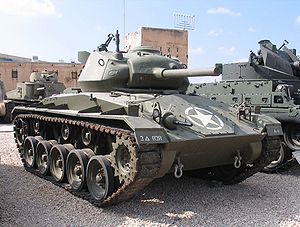
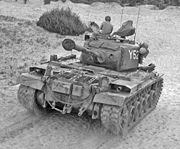
Korean War
The Korean War was a conventional war between South Korea, supported by the United Nations, and North Korea, supported by the People's Republic of China , with military material aid from the Soviet Union...
M24 Chaffee's were the first U.S. tanks to fight the North Korea
North Korea
The Democratic People’s Republic of Korea , , is a country in East Asia, occupying the northern half of the Korean Peninsula. Its capital and largest city is Pyongyang. The Korean Demilitarized Zone serves as the buffer zone between North Korea and South Korea...
n T-34-85s
T-34
The T-34 was a Soviet medium tank produced from 1940 to 1958. Although its armour and armament were surpassed by later tanks of the era, it has been often credited as the most effective, efficient and influential design of World War II...
. The M24 fared poorly against these much better-armed and armored medium tanks which were superior to the M-24
M24 Chaffee
The Light Tank M24 was an American light tank used during World War II and in postwar conflicts including the Korean War and with the French in the War in Algeria and First Indochina War. In British service it was given the service name Chaffee, after the United States Army General Adna R...
. M24s were more successful later in the war in their reconnaissance role, supported by heavier tanks such as the M4, M26, and M46
M46 Patton
The M46 was a medium tank that was designed in the United States. It was the first tank to be named after General George S. Patton, commander of the U.S...
.
The heavier but older M26 Pershing
M26 Pershing
The Heavy Tank M26 Pershing was an American heavy tank briefly used in World War II and in the Korean War. It was named after General John Pershing, who led the American Expeditionary Force in Europe in World War I....
was deemed unsatisfactory due to its inferior mobility, which was unsuitable for a medium tank role as it used the same engine that powered the much lighter M4 Sherman, and in November, 1949, the upgraded M26 received a new power plant and a main gun with bore evacuator
Bore evacuator
A bore evacuator is a device on the gun barrel of an armoured fighting vehicle which helps prevent poisonous propellant gases from venting back into the vehicle's fighting compartment when the gun breech is opened to load another round. Bore evacuators are most often used on large-calibre tank...
, and the M46 Patton
M46 Patton
The M46 was a medium tank that was designed in the United States. It was the first tank to be named after General George S. Patton, commander of the U.S...
designation. Less than a thousand were upgraded to M46 standard.

T-34
The T-34 was a Soviet medium tank produced from 1940 to 1958. Although its armour and armament were surpassed by later tanks of the era, it has been often credited as the most effective, efficient and influential design of World War II...
, which were encountered in relatively small numbers. By the end of 1950, 200 M46 Pattons had been fielded, forming about 15% of US tank strength in Korea; the balance of 1,326 tanks shipped to Korea during 1950 included 679 M4A3 Shermans, 309 M26 Pershings, and 138 M24 Chaffee light tanks. Subsequent shipments of M46 and M46A1 Pattons allowed all remaining M26 Pershings to be withdrawn during 1951, and most Sherman equipped units were also reequipped.
By 1953 the M24 Chaffee's were completely replaced by the new M41 tank in the United States Army
United States Army
The United States Army is the main branch of the United States Armed Forces responsible for land-based military operations. It is the largest and oldest established branch of the U.S. military, and is one of seven U.S. uniformed services...
which was rushed to the battlefield. It was later designated the M41 Walker Bulldog
M41 Walker Bulldog
The M41 Walker Bulldog was a U.S. light tank developed to replace the M24 Chaffee. It was named for General Walton Walker who died in a jeep accident in Korea...
. The M41 was an agile and well armed. On the other hand, it was noisy, fuel-hungry and heavy enough to cause problems with air transport. The Walker Bulldog saw limited combat with the U.S. Army during the Korean War
Korean War
The Korean War was a conventional war between South Korea, supported by the United Nations, and North Korea, supported by the People's Republic of China , with military material aid from the Soviet Union...
, but the conflict served as a testing ground to work out the tank's deficiencies, especially with its rangefinder.
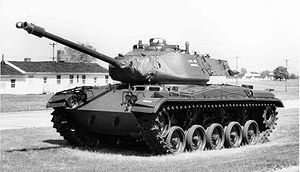
Interwar
The M47 PattonM47 Patton
The M47 Patton is an American medium tank, the second tank to be named after General George S. Patton, commander of the U.S. Third Army during World War II and one of the earliest American advocates of tanks in battle. It was a further development of the M46 Patton tank.-History:The M47 was the U.S...
was intended to replace the M46 Patton
M46 Patton
The M46 was a medium tank that was designed in the United States. It was the first tank to be named after General George S. Patton, commander of the U.S...
and M4 Sherman
M4 Sherman
The M4 Sherman, formally Medium Tank, M4, was the primary tank used by the United States during World War II. Thousands were also distributed to the Allies, including the British Commonwealth and Soviet armies, via lend-lease...
tanks. It had a 90 mm gun and a crew of 5. Despite it being the primary tank of the US it never saw combat while in US service. In Early 1951, the U.S. initiated the design of the M48 Patton
M48 Patton
The M48 Patton is a medium tank that was designed in the United States. It was the third and final tank to be officially named after General George S. Patton, commander of the U.S. Third Army during World War II and one of the earliest American advocates for the use of tanks in battle It was a...
, designated the T-48 with a 90 mm cannon. The T48 featured a new turret, new redesigned hull and an improved suspension. The hull machine gunner position was removed, reducing the crew to 4. On 2 April 1953, the Ordnance Technical Committee Minutes (OTCM), standardized the last of the Patton series tanks as the M48 Patton.
Nearly 12,000 M48s were built from 1952 to 1959. The early designs, up to the M48A2, were powered by a gasoline 12 cylinder engine which was coupled with an auxiliary 8 cylinder engine. The gas engine gave the tank a short operating range and were prone to catching fire when hit. This version was considered unreliable.
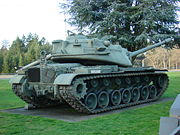
Detroit Arsenal Tank Plant
The Detroit Arsenal Tank Plant was the first manufacturing plant ever built for the mass production of tanks in the United States. Established in 1940 under Chrysler, this plant was owned by the U.S. government until 1996. It was designed by architect Albert Kahn...
and the first units were accepted in 1957.
The M103 was designed to counter Soviet heavies. Its long-ranged 120 mm cannon was designed to hit enemy tanks at extreme distances, but it was never used in combat. Of the 300 M103s built, Most went to the Marines. The tank was relatively underpowered and the drive systems were fragile.The turret of the M103 was larger than that of the M48 or the M60 to make room for the huge 120 mm gun and the two loaders assigned to it, in addition to the gunner and the commander. The driver sat in the hull. The gun was capable of elevation from +15 to -8 degrees.
While the US Army deactivated its heavy armor units with the reception of the new M60 series main battle tanks in 1960, the remaining M103s stayed within the US Marine Corps inventory until they began receiving the M60 series MBT. With the disappearance of the heavy tank from US forces came the full acceptance of the main battle tank
Main battle tank
A main battle tank , also known as a battle tank or universal tank, is a tank that fills the heavy direct fire role of many modern armies. They were originally conceived to replace the light, medium, heavy and super-heavy tanks. Development was spurred onwards in the Cold War with the development...
in 1960 for the US Army, and later for the US Marine Corps.
Vietnam War era
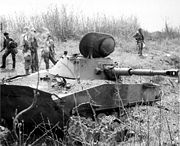
M48 Patton
The M48 Patton is a medium tank that was designed in the United States. It was the third and final tank to be officially named after General George S. Patton, commander of the U.S. Third Army during World War II and one of the earliest American advocates for the use of tanks in battle It was a...
saw tank to tank duels. on March 3, 1969, the Special Forces camp at Ben Het was attacked by the NVA 202nd Armored Regiment. The 202nd was tasked with the mission of destroying the camp's 175 mm self propelled guns. One of the PT-76s had detonated a land mine, which not only alerted the camp, but also lit up the other PT-76s attacking the firebase. Flares had been sent up, thus exposing adversary tanks, but sighting in on muzzle flashes, one PT-76 scored a direct hit on the turret of a M48, killing two Patton crewmen and wounding two more. A second Patton, using the same technique, destroyed a PT-76 with their second shot. At daybreak, the battlefield revealed the wreckage of two PT-76s and one BTR-50 armored personnel carrier.

Vietnam War
The Vietnam War was a Cold War-era military conflict that occurred in Vietnam, Laos, and Cambodia from 1 November 1955 to the fall of Saigon on 30 April 1975. This war followed the First Indochina War and was fought between North Vietnam, supported by its communist allies, and the government of...
, over 600 Pattons would be deployed with US Forces during the war. The initial M48s landed with the US Marines in 1965. Remaining Pattons deployed to South Vietnam were in three U.S. Army battalions, the 1-77th Armor
77th Armor Regiment (United States)
The 77th Armor is an armored regiment of the United States Army. The 77th Armor Regiment is part of the U.S. Army Regimental System with only a single battalion, the 1st Battalion, 77th Armor Regiment, and is therefore classified as both a single battalion, and the remainder of the Regiment itself...
near the DMZ, the 1-69th Armor in the Central Highlands, and the 2-34th Armor
34th Armor Regiment (United States)
The 34th Armor Regiment is an armored regiment of the United States Army formed in 1941.-Lineage:Constituted 28 August 1941 in the Regular Army as the 34th Armored Regiment and assigned to the 5th Armored Division...
near the Mekong Delta. Each battalion consisted of approximately fifty seven tanks. M48s were also used by Armored Cavalry Squadrons in Vietnam, until replaced by M551 Sheridan tanks. The M67A1 flamethrower
Flamethrower
A flamethrower is a mechanical device designed to project a long controllable stream of fire.Some flamethrowers project a stream of ignited flammable liquid; some project a long gas flame. Most military flamethrowers use liquids, but commercial flamethrowers tend to use high-pressure propane and...
tank (nicknamed the Zippo
Zippo
A Zippo lighter is a refillable, metal lighter manufactured by Zippo Manufacturing Company of Bradford, Pennsylvania, U.S. Thousands of different styles and designs have been made in the seven decades since their introduction including military ones for specific regiments.-Establishment:George G...
) was an M48 variant used in Vietnam.

Army of the Republic of Vietnam
The Army of the Republic of Viet Nam , sometimes parsimoniously referred to as the South Vietnamese Army , was the land-based military forces of the Republic of Vietnam , which existed from October 26, 1955 until the fall of Saigon on April 30, 1975...
(ARVN) forces, in particular creating the ARVN 20th Tank Regiment; which supplemented their M41 Walker Bulldog
M41 Walker Bulldog
The M41 Walker Bulldog was a U.S. light tank developed to replace the M24 Chaffee. It was named for General Walton Walker who died in a jeep accident in Korea...
units. During the North Vietnamese Army (NVA) Easter Offensive in 1972, tank clashes between NVA T-54/PT-76
PT-76
The PT-76 is a Soviet amphibious light tank which was introduced in the early 1950s and soon became the standard reconnaissance tank of the Soviet Army and the other Warsaw Pact armed forces. It was widely exported to other friendly states, like India, Iraq, North Korea and North Vietnam. Overall,...
and ARVN M48/M41 units became commonplace, but on 23 April 1972, tankers of the 20th Tank Regiment were attacked by an NVA infantry-tank team, which was equipped with the new 9M14M Malyutka (NATO designation
NATO reporting name
NATO reporting names are classified code names for military equipment of the Eastern Bloc...
: Sagger) wire guided anti-tank missile. During this battle, one M48A3 Patton tank and one M113
M113 armored personnel carrier
The M113 is a fully tracked armored personnel carrier that has formed the backbone of the United States Army's mechanized infantry units from the time of its first fielding in Vietnam in April 1962. The M113 was the most widely used armored vehicle of the U.S...
Armored Cavalry Assault Vehicle (ACAV) were destroyed, becoming the first losses to the Sagger missile; losses that would echo on an even larger scale a year later during the Yom Kippur War
Yom Kippur War
The Yom Kippur War, Ramadan War or October War , also known as the 1973 Arab-Israeli War and the Fourth Arab-Israeli War, was fought from October 6 to 25, 1973, between Israel and a coalition of Arab states led by Egypt and Syria...
in the Middle East in 1973.
In the mid-1970s, the M48A5 upgrade was developed to allow the vehicle to carry the heavier 105mm gun. This was designed to bring the M48s up to speed with the M60
M60 Patton
The 105 mm Gun Full Tracked Combat Tank, M60, also known unofficially as the M60 Patton, is a first-generation main battle tank introduced in December 1960. It was widely used by the U.S. and its Cold War allies, especially those in NATO, and remains in service throughout the world today...
tanks then in regular use. Most of the M48s were placed into service with reserve units by this time. By the mid-1990s, the M48s were phased out.
The M48s performed admirably in Vietnam in the infantry-support role. However, there were few actual tank versus tank battles. The M48s provided adequate protection for its crew from small arms, mines, and rocket-propelled grenades.
The plans were laid in the US in the late fifties, for a tank with a 105 mm main gun and a redesigned hull offering better armor protection. The resulting M60 largely resembled the M48 it was based on, but has significant differences. The M60 mounted a bore evacuated
Bore evacuator
A bore evacuator is a device on the gun barrel of an armoured fighting vehicle which helps prevent poisonous propellant gases from venting back into the vehicle's fighting compartment when the gun breech is opened to load another round. Bore evacuators are most often used on large-calibre tank...
105 mm main gun, had a hull with a straight front slope where as the M48's hull was rounded, had three support rollers per side to the M48's five, and had road wheels constructed from aluminum rather than steel.
The hull of the M60 was a single piece steel casting divided into three compartments, with the driver in front, fighting compartment in the middle and engine at the rear. The driver looked through three M27 day periscopes, one of which could be replaced by a night vision periscope. Initially, the M60 had essentially the same turret shape as the M48, but this was subsequently replaced with a distinctive "needlenose" design that minimized frontal cross-section to enemy fire. The M60 was the last U.S. main battle tank to utilize homogeneous steel armor for protection. It was also the last to feature either the M60 machine gun
M60 machine gun
The M60 is a family of American general-purpose machine guns firing 7.62×51mm NATO cartridges from a disintegrating belt of M13 links...
or an escape hatch under the hull.
Originally designated the M68, the new vehicle was put into production in 1959, reclassified as the M60, and entered service in 1960. Over 15,000 M60s (all variants) were constructed.
In 1963, the M60 was upgraded to the M60A1. This new variant, which stayed in production until 1980, featured a larger, better-shaped turret and improvements to the armor protection and shock absorbers. The M60A1 was also equipped with a stabilization system for the main gun. However, the M60A1 was still not able to fire on the move, as the system only kept the gun pointed in the same general direction while the tank was traveling cross country. It did however enable the coaxial machine gun to be brought to bear while moving.

M551 Sheridan
The M551 Sheridan was a light tank developed by the United States and named after Civil War General Philip Sheridan. It was designed to be landed by parachute and to swim across rivers. It was armed with the technically advanced but troublesome M81/M81E1 152mm gun/launcher which fired conventional...
was initiated when the replacement for the M41 Walker Bulldog
M41 Walker Bulldog
The M41 Walker Bulldog was a U.S. light tank developed to replace the M24 Chaffee. It was named for General Walton Walker who died in a jeep accident in Korea...
, the T92 Light Tank
T92 Light Tank
T92 Light Tank was an innovative American light tank developed in 1950s by Aircraft Armaments. At 18.5 tonnes, 5m length, it was designed as an airborne/airdropped replacement for the 5 tonnes heavier M41 Walker Bulldog. The T92 was never accepted into service.The main gun was a conventional...
, was canceled.
The need for even lighter weight to make the tank transportable presented the design with a particularly difficult problem; guns capable of defeating modern tanks at reasonable ranges were so large that they demanded a large vehicle to carry them, so large that they couldn't be used as a "light" tank. The use of HEAT
Heat
In physics and thermodynamics, heat is energy transferred from one body, region, or thermodynamic system to another due to thermal contact or thermal radiation when the systems are at different temperatures. It is often described as one of the fundamental processes of energy transfer between...
rounds instead of conventional penetrating ammunition could address this, but HEAT rounds work better at larger calibers. Gun weight is typically the product of caliber and muzzle velocity
Muzzle velocity
Muzzle velocity is the speed a projectile has at the moment it leaves the muzzle of the gun. Muzzle velocities range from approximately to in black powder muskets , to more than in modern rifles with high-performance cartridges such as the .220 Swift and .204 Ruger, all the way to for tank guns...
, so in the case of the XM551 they sacrificed the muzzle velocity, producing the low-velocity but relatively large-caliber 152 mm M81. HEAT rounds fired by the M81 could defeat any contemporary tank at shorter ranges, but its low velocity made it difficult to use at longer ranges, especially against moving targets. The large low-velocity gun was also ideal for infantry support, where higher performance anti-tank guns would often fire right through soft targets and their small-caliber guns left little room for explosive filler. The M551 Sheridan
M551 Sheridan
The M551 Sheridan was a light tank developed by the United States and named after Civil War General Philip Sheridan. It was designed to be landed by parachute and to swim across rivers. It was armed with the technically advanced but troublesome M81/M81E1 152mm gun/launcher which fired conventional...
tank would thus be ideal for both direct fire support as well as short-distance anti-tank engagements.
The only niche where the M551 Sheridan
M551 Sheridan
The M551 Sheridan was a light tank developed by the United States and named after Civil War General Philip Sheridan. It was designed to be landed by parachute and to swim across rivers. It was armed with the technically advanced but troublesome M81/M81E1 152mm gun/launcher which fired conventional...
was not ideal was the medium and long-range anti-tank engagement. The muzzle velocity was so low that a HEAT round fired at longer ranges would have to be "lofted", making aiming difficult, and the flight time would be so long that a moving target would be very difficult to hit. However, it appeared there was a solution to this problem by equipping the tank with gun-fired anti-tank missiles. For longer range engagements a missile would be fired instead of a HEAT round, and although its velocity would also be relatively slow, the guidance system would make a hit highly likely anyway. The M551 Sheridan
M551 Sheridan
The M551 Sheridan was a light tank developed by the United States and named after Civil War General Philip Sheridan. It was designed to be landed by parachute and to swim across rivers. It was armed with the technically advanced but troublesome M81/M81E1 152mm gun/launcher which fired conventional...
appeared to offer the best of both worlds; for infantry support the large calibre gun allowed it to fire full-sized artillery rounds and canister shot, while also giving it reasonable short-range anti-tank performance from the same gun.
The M551 Sheridan
M551 Sheridan
The M551 Sheridan was a light tank developed by the United States and named after Civil War General Philip Sheridan. It was designed to be landed by parachute and to swim across rivers. It was armed with the technically advanced but troublesome M81/M81E1 152mm gun/launcher which fired conventional...
had a steel turret and aluminum hull. It was powered by a large diesel engine. The M551 thus had excellent mobility, able to run at speeds up to 45 mph, which at that time was unheard of for a tracked vehicle. Swimming capability was provided by a flotation screen. Production started on late July 1966, and entered service in June 1967. More than 1,600 M551s were built between 1966 and 1970. Total cost of the M551 program was $1.3 billion.
The vehicle proved to be very noisy and unreliable under combat conditions. The armor was thin enough that it could be penetrated even by heavy machine gun rounds as well as being highly vulnerable to mines. Firing the gun would often adversely affect the delicate electronics, which were at the early stages of transitioning to solid state, so the missile and guidance system was omitted from vehicles deployed to Vietnam. The gun had problems with cracks developing near the breech after repeated firing. Most field units were modified to help address the problem but gun also was criticized for having too much recoil for the vehicle weight, the second and even third road wheels coming clear off the ground when the main gun fired.
The Sheridan saw extensive action in the Vietnam War
Vietnam War
The Vietnam War was a Cold War-era military conflict that occurred in Vietnam, Laos, and Cambodia from 1 November 1955 to the fall of Saigon on 30 April 1975. This war followed the First Indochina War and was fought between North Vietnam, supported by its communist allies, and the government of...
, being assigned to nearly all armored cavalry squadrons in country. In 1969, armored cavalry units began replacing their M48 Patton
M48 Patton
The M48 Patton is a medium tank that was designed in the United States. It was the third and final tank to be officially named after General George S. Patton, commander of the U.S. Third Army during World War II and one of the earliest American advocates for the use of tanks in battle It was a...
tanks.

The Sheridan was much appreciated by the infantry who were desperate for direct-fire support, which generally served in combination with ACAVs (M113s) as armored cavalry units consisted of both M113
M113 Armored Personnel Carrier
The M113 is a fully tracked armored personnel carrier that has formed the backbone of the United States Army's mechanized infantry units from the time of its first fielding in Vietnam in April 1962. The M113 was the most widely used armored vehicle of the U.S...
s and M551s as part of their TO&E. Armor units consisted solely of tanks (minus headquarters company) and Mechanized Infantry units consisted solely of M113s. In this role the real problem with the Sheridan was its limited ammunition load of only 20 rounds and 8 missiles (though M551s in Vietnam service were not equipped with missiles or their guidance equipment, increasing the basic load of conventional rounds).
A common field-modification was to mount a large steel shield, known as an "ACAV set" (Armored Cavalry Assault Vehicle), around the commander's 50-cal. (12.7 mm) gun, allowing it to be fired with some level of protection. The driver has an unusual rotating hatch which has vision blocks when rotated forward. Included with the set was an extra layer of steel belly armor which was bolted onto the vehicle's bottom, although only covering from the front to half way to the end, possibly due to weight reasons.
A standard modification made during the mid-70's was the addition of the "Cereal Bowl" commander's copula. This mod came about due to the broken rib effect that occurred when the Sheridan fired conventional rounds, the recoil would pitch the TC against the armor plating resulting in cracked ribs.
Post-Vietnam
The Army began to phase out the Sheridan in 1978, although at the time there was no real replacement. Nevertheless the 82nd AirborneU.S. 82nd Airborne Division
The 82nd Airborne Division is an active airborne infantry division of the United States Army specializing in parachute landing operations. Based at Fort Bragg, North Carolina, the 82nd Airborne Division is the primary fighting arm of the XVIII Airborne Corps....
were able to keep them on until 1996. The Sheridan was the only air-deployable tank in the inventory, and as an elite force they had considerably more "pull" than general infantry and armor units who were forced to get rid of them. Their units were later upgraded to the M551A1 model, including a thermal sighting system for the commander and gunner.
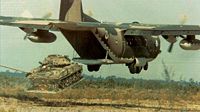
Combat
Combat, or fighting, is a purposeful violent conflict meant to establish dominance over the opposition, or to terminate the opposition forever, or drive the opposition away from a location where it is not wanted or needed....
occurred during Operation Just Cause in Panama
Panama
Panama , officially the Republic of Panama , is the southernmost country of Central America. Situated on the isthmus connecting North and South America, it is bordered by Costa Rica to the northwest, Colombia to the southeast, the Caribbean Sea to the north and the Pacific Ocean to the south. The...
in 1989, when fourteen M551's were deployed; four were transported by C-5 Galaxies and ten were dropped by air, but two Sheridans were destroyed upon landing. The Sheridans' performance received mixed reviews. They were lauded by their operators and some commanders as providing firepower in needed situations to destroy hard targets. However, the Sheridans' employment of only HEAT rounds limited their effectiveness against reinforced concrete construction.
51 Sheridans were deployed in the Gulf War
Gulf War
The Persian Gulf War , commonly referred to as simply the Gulf War, was a war waged by a U.N.-authorized coalition force from 34 nations led by the United States, against Iraq in response to Iraq's invasion and annexation of Kuwait.The war is also known under other names, such as the First Gulf...
as some of the first tanks sent. They would not be very effective against the Russian-built T-72
T-72
The T-72 is a Soviet-designed main battle tank that entered production in 1970. It is developed directly from Obyekt-172, and shares parallel features with the T-64A...
s. Their role was limited by age and light armor to reconnaissance, possibly 6 or less Shillelagh missiles were fired at Iraqi bunkers, these fewer than a half-dozen missiles, were the only time that the Shillelagh had been fired in a combat environment, from the inventory of the aforementioned 88,000 missiles produced.
Several attempts to upgun or replace the Sheridan have been made, but none were successful. Several experimental versions of the Sheridan mounting a new turret carrying a 105mm gun were made, but the resulting recoil was too great. Several possible replacements for the M551 were tested as a part of the XM8 Armored Gun System
M8-AGS
The United Defense M8 Armored Gun System was a light tank that was intended to replace the M551 Sheridan in the 82nd Airborne Division, as well as being expected to replace TOW-equipped Humvees in the 2d Armored Cavalry Regiment . The M8 project was eventually canceled...
and Expeditionary tank
Expeditionary tank
The Expeditionary tank was a United States light tank developed for the Armored Gun System competition in the 1980s by Teledyne Vehicle Systems .-Development:...
efforts of the early and late 80's respectively, but none of these entered service. The Stryker Mobile Gun System, has replaced the light tank role of the United States.
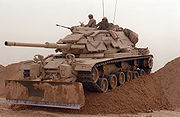
M60 Patton
The 105 mm Gun Full Tracked Combat Tank, M60, also known unofficially as the M60 Patton, is a first-generation main battle tank introduced in December 1960. It was widely used by the U.S. and its Cold War allies, especially those in NATO, and remains in service throughout the world today...
was upgraded and designated the M60A2. It featured an entirely new low-profile turret with a commander's machine-gun cupola
Cupola
In architecture, a cupola is a small, most-often dome-like, structure on top of a building. Often used to provide a lookout or to admit light and air, it usually crowns a larger roof or dome....
on top, giving the commander a good view and field of fire while under armor but spoiling the low profile. It also featured a 152 mm cannon, which fired conventional rounds as well as guided missile
Guided Missile
Guided Missile is a London based independent record label set up by Paul Kearney in 1994.Guided Missile has always focused on 'the underground', preferring to put out a steady flow of releases and developing the numerous GM events around London and beyond....
s.
The M60A2 proved a disappointment, though technical advancements would pave the way for future tanks. The Shillelagh/M60A2 system was phased out from active units by 1981, and the turrets scrapped. Most of the M60A2 tanks were rebuilt as M60A3.
In 1978, work began on the M60A3 variant. It featured a number of technological enhancements, including smoke dischargers, a new rangefinder, and M21 ballistic computer, and a turret stabilization system. In addition it reverted back to the 105 mm cannon. All active American M60s eventually underwent the conversion to the A3 model. The M60A3 was phased out of US service in 1997.

M1 Abrams
The M1 Abrams is a third-generation main battle tank produced in the United States. It is named after General Creighton Abrams, former Army Chief of Staff and Commander of US military forces in Vietnam from 1968 to 1972. The M1 is a well armed, heavily armored, and highly mobile tank designed for...
were delivered by Chrysler Defense and General Motors
General Motors
General Motors Company , commonly known as GM, formerly incorporated as General Motors Corporation, is an American multinational automotive corporation headquartered in Detroit, Michigan and the world's second-largest automaker in 2010...
armed with a 105 mm rifled cannon. The Chrysler Defense design was selected for development as the M1. In 1979, General Dynamics
General Dynamics
General Dynamics Corporation is a U.S. defense conglomerate formed by mergers and divestitures, and as of 2008 it is the fifth largest defense contractor in the world. Its headquarters are in West Falls Church , unincorporated Fairfax County, Virginia, in the Falls Church area.The company has...
Land Systems Division purchased Chrysler Defense. The M1 Abrams
M1 Abrams
The M1 Abrams is a third-generation main battle tank produced in the United States. It is named after General Creighton Abrams, former Army Chief of Staff and Commander of US military forces in Vietnam from 1968 to 1972. The M1 is a well armed, heavily armored, and highly mobile tank designed for...
came from the diverted funds from the over budget and impractical MBT-70
MBT-70
The MBT-70 was a 1960s German-U.S. joint project to develop a new main battle tank, which was to be equipped with a number of advanced features. It utilized a newly developed hydropneumatic "kneeling" suspension and housed the entire crew in the large turret...
and XM815 projects.
The M1 was the first of its kind. It feature a low profile turret and for the first time ever on a tank, composite chobham
Chobham
Chobham may mean:* Chobham, Surrey, a town in Surrey, England* Chobham Common, located near Chobham, Surrey, location of a British tank research centre* Chobham armour, composite armour for tanksSee also:* Cobham...
armor. Despite all these advances, the Abrams still retained the 4-man crew of the M60 Patton
M60 Patton
The 105 mm Gun Full Tracked Combat Tank, M60, also known unofficially as the M60 Patton, is a first-generation main battle tank introduced in December 1960. It was widely used by the U.S. and its Cold War allies, especially those in NATO, and remains in service throughout the world today...
as the autoloader
Autoloader
An autoloader or auto-loader is a mechanical aid or replacement for the personnel that load ordnance into crew-served weapons, such as tanks and artillery...
was considered unproven and risky. Over 3200 M1 Abrams were produced and first entered US Army service in 1980. About 6000 upgraded M1A1 Abrams were produced and used a 120 mm smoothbore
Smoothbore
A smoothbore weapon is one which has a barrel without rifling. Smoothbores range from handheld firearms to powerful tank guns and large artillery mortars.-History of firearms and rifling:...
cannon, improved armor, and a CBRN
CBRN
CBRN is an initialism for chemical, biological, radiological, and nuclear. It is used to refer to situations in which any of these four hazards have presented themselves. The term CBRN is a replacement for the cold war term NBC , which had replaced the term ABC that was used in the fifties...
protection system.
As the Abrams entered service in the 1980s, they would operate alongside M60A3 Patton. These exercises usually took place in Western Europe, especially West Germany, but also in some other countries like South Korea. During such training, Abrams crews honed their skills for use against the Soviet Union. However, by 1991 the USSR had collapsed and the Abrams would have its trial by fire in the Middle East.
Gulf War/Iraq war

The Iraqi forces were initially regular army units, equipped with tanks such as T-54/55 tanks and T-62s. The Coalition main battle tank
Main battle tank
A main battle tank , also known as a battle tank or universal tank, is a tank that fills the heavy direct fire role of many modern armies. They were originally conceived to replace the light, medium, heavy and super-heavy tanks. Development was spurred onwards in the Cold War with the development...
s, such as the U.S. M1 Abrams
M1 Abrams
The M1 Abrams is a third-generation main battle tank produced in the United States. It is named after General Creighton Abrams, former Army Chief of Staff and Commander of US military forces in Vietnam from 1968 to 1972. The M1 is a well armed, heavily armored, and highly mobile tank designed for...
, British Challenger 1
Challenger 1 tank
The British FV4030/4 Challenger 1, was the main battle tank of the British Army from 1983 to the mid 1990s, when it was superseded by the Challenger 2. It is also currently used by the Jordanian Armed Forces as their main battle tank after heavy modifications...
, and Kuwaiti M-84
M-84
The M-84 is a Yugoslav 2nd generation main battle tank. The M-84 is in service in Bosnia and Herzegovina, Croatia, Kuwait, Slovenia and Serbia.-Development and production:...
AB were vastly superior to the Chinese Type 69 and domestically built T-72 tanks used by the Iraqis, with crews better trained and armoured doctrine better developed.
The majority of Iraqi armored forces still used old Chinese Type 59
Type 59
The Type 59 main battle tank is a Chinese produced version of the Soviet T-54A tank, an improvement over the ubiquitous T-54/55. The first vehicles were produced in 1958 and it was accepted into service in 1959, with serial production beginning in 1963...
s and Type 69s, Soviet-made T-55
T-55
The T-54 and T-55 tanks were a series of main battle tanks designed in the Soviet Union. The first T-54 prototype appeared in March 1945, just before the end of the Second World War. The T-54 entered full production in 1947 and became the main tank for armored units of the Soviet Army, armies of...
s from the 1950s and 1960s, and some poor quality Asad Babil tanks
Lion of Babylon tank
The Lion of Babylon or Asad Babil was an Iraqi-built version of the Soviet T-72 main battle tank, assembled in a factory established in the 1980s near Taji, north of Baghdad....
(domestically assembled tank based on Polish T-72 hulls with other parts of mixed origin). These machines were not equipped with up-to-date equipment, such as thermal sights or laser rangefinders, and their effectiveness in modern combat was very limited.
The Iraqis failed to find an effective countermeasure to the thermal sights and sabot rounds used by the Coalition tanks. This equipment enabled them to engage and destroy Iraqi tanks from more than three times the range that Iraqi tanks could engage coalition tanks. The Iraqi crews used old, cheap steel penetrators
Kinetic energy penetrator
A kinetic energy penetrator is a type of ammunition which, like a bullet, does not contain explosives and uses kinetic energy to penetrate the target....
against the advanced Chobham Armour
Chobham armour
Chobham armour is the name informally given to a composite armour developed in the 1960s at the British tank research centre on Chobham Common, Surrey, England...
of the U.S. and British tanks, with ineffective results.
In the Iraqi war in 2003, a Iraqi division the 6th Armored Division of the Iraqi Army
Iraqi Army
The Iraqi Army is the land component of the Iraqi military, active in various forms since being formed by the British during their mandate over the country after World War I....
. which was equipped with T-55s and BMP-1
BMP-1
The BMP-1 is a Soviet amphibious tracked infantry fighting vehicle. BMP stands for Boyevaya Mashina Pekhoty 1 , meaning "infantry fighting vehicle". The BMP-1 was the world's first mass-produced infantry fighting vehicle...
s defending the control of key bridges over the Euphrates River and the Saddam Canal at Nasiriyah, were decimated by US Marines with M1 Abrams
M1 Abrams
The M1 Abrams is a third-generation main battle tank produced in the United States. It is named after General Creighton Abrams, former Army Chief of Staff and Commander of US military forces in Vietnam from 1968 to 1972. The M1 is a well armed, heavily armored, and highly mobile tank designed for...
, and the division as a unit rendered incapable for combat during the Battle of Nasiriyah
Battle of Nasiriyah
The Battle of Nasiriyah was one of the first major battles of the 2003 invasion of Iraq. Heavy fighting took place in the southern Iraqi city of Nasiriyah between Iraqi forces and U.S. Marines over control of key bridges over the Euphrates River and the Saddam Canal.The battle began early on 23...
in March 2003, during the invasion.
In addition to the T-54/55 and T-62
T-62
The T-62 is a Soviet main battle tank, a further development of the T-55. Its 115 mm gun was the first smoothbore tank gun in use.The T-62 was produced between 1961 and 1975. It became a standard tank in the Soviet arsenal, partly replacing the T-55, although that tank continued to be...
tanks that Iraq had, the most feared to US amoured forces were the T-72
T-72
The T-72 is a Soviet-designed main battle tank that entered production in 1970. It is developed directly from Obyekt-172, and shares parallel features with the T-64A...
tanks in the Iraqi forces. Only Republican Guard
Iraqi Republican Guard
The Iraqi Republican Guard was a branch of the Iraqi military during the presidency of Saddam Hussein. It later became the Republican Guard Corps, and then the Republican Guard Forces Command with its expansion into two corps....
divisions were equipped with Iraqi-modified T-72s. Many of the Iraqi T-72s were dug-in or hidden in groves, and then used to ambush the US or British tanks. In the war, the Iraqi T-72s were the preferred target for Apache helicopters and A-10s, in an attempt to diminish the combat power of Republican Guard
Iraqi Republican Guard
The Iraqi Republican Guard was a branch of the Iraqi military during the presidency of Saddam Hussein. It later became the Republican Guard Corps, and then the Republican Guard Forces Command with its expansion into two corps....
divisions. The only chance for the Asad Babil T-72s against American tanks was to lure them to close range combat, or trying to ambush them from dug-in positions.
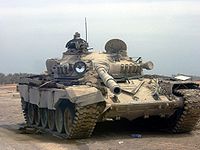
2003 invasion of Iraq
The 2003 invasion of Iraq , was the start of the conflict known as the Iraq War, or Operation Iraqi Freedom, in which a combined force of troops from the United States, the United Kingdom, Australia and Poland invaded Iraq and toppled the regime of Saddam Hussein in 21 days of major combat operations...
) when US tanks engaged their counterparts from just 50 yards, shattering seven enemy T-72s without losses. The Lion of Babylon T-72
T-72
The T-72 is a Soviet-designed main battle tank that entered production in 1970. It is developed directly from Obyekt-172, and shares parallel features with the T-64A...
was utterly outclassed by the M1 Abrams
M1 Abrams
The M1 Abrams is a third-generation main battle tank produced in the United States. It is named after General Creighton Abrams, former Army Chief of Staff and Commander of US military forces in Vietnam from 1968 to 1972. The M1 is a well armed, heavily armored, and highly mobile tank designed for...
, the Challenger and by any other contemporary Western main battle tank during the 2003 invasion of Iraq.
See also
- History of the tankHistory of the tankThe history of the tank began in World War I, when armoured all-terrain fighting vehicles were first deployed as a response to the problems of trench warfare, ushering in a new era of mechanized warfare. Though initially crude and unreliable, tanks eventually became a mainstay of ground armies...
- Tanks in World War ITanks in World War IThe development of tanks in World War I began as a solution to the stalemate which trench warfare had brought to the western front. The first prototype of the Mark I tank was tested for the British Army on September 8th 1915...
- Comparison of World War I tanksComparison of World War I tanks-Tanks used in World War I:-Immediate post war tanks:Tanks planned for production and with completed prototypes during the war, but entered service after it ended....
- List of interwar armoured fighting vehicles
- Tanks in World War IITanks in World War IITanks played a great role in World War II. Invented by the British in World War I, the tank gradually improved in the inter-war period and also saw rapid changes in the Second World War...
- Comparison of early World War II tanksComparison of early World War II tanksThis table compare the tanks in use by the belligerent nations of Europe at the start of the Second World War, employed in the Polish Campaign , the Fall of France , and Operation Barbarossa ....

